New Feature Alert: Embedding Stories
Posted by Remya Padmadas on November 15, 2016At StoryWeaver we're always thinking of new ideas and features that will be of use to our community. Sometimes, these are in response to requests from our users (like when we added the 'Created by Children' tag, that allows young authors to create their own stories and then see their names on the cover page of their book) and sometimes, we envisage an idea that our users don't even know they need yet!
Our new 'embed' function falls into the second category. All the content on StoryWeaver is openly licensed under the most liberal Creative Commons license, CC-BY4.0 allowing users to read, translate, share and print the stories and images for free. However, till now, users could only share stories via a url. We decided to explore adding an embed function so that users could embed StoryWeaver titles onto their websites or personal blogs, so that the reading experience is contained to their site.

The new embed icon
How to embed stories from StoryWeaver
1. Decide on which story (or stories) you want to embed on your website or blog. Let's choose 'नागमोडी नागोबा'. Click on the story card.
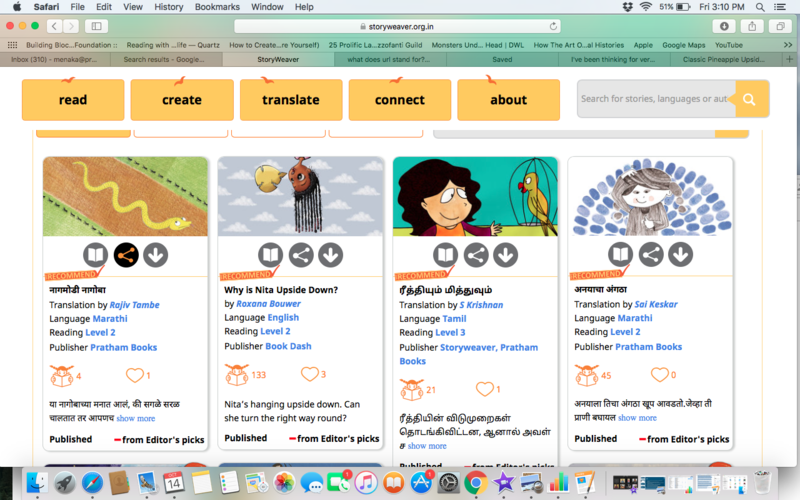
2. Look for the embed icon on the story details page. See the screen shot attached.
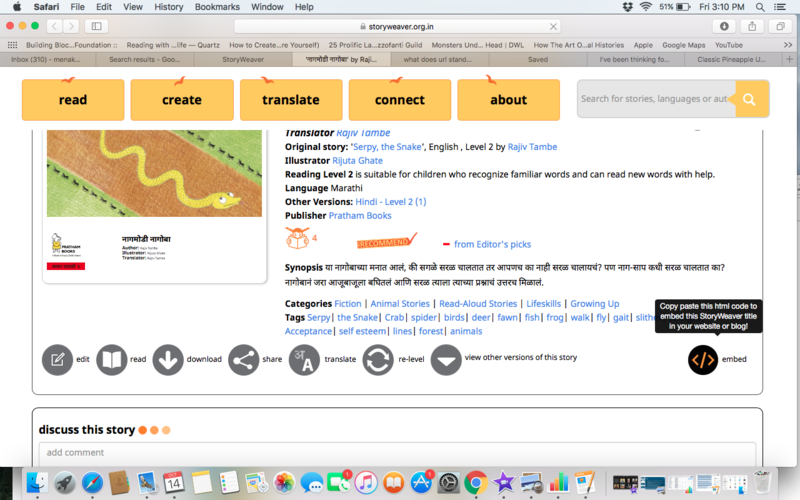
3. Click on the icon. A small window will pop up with html code. Copy the code to your clipboard.
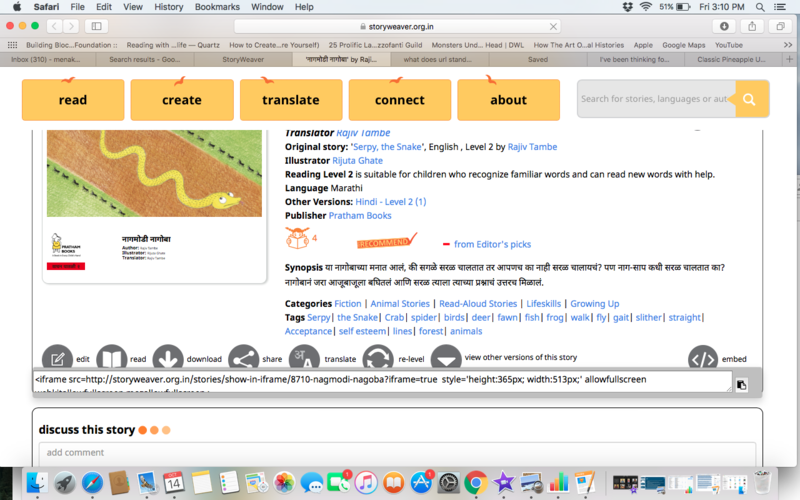
4. On your blog or website, look for the Source button or HTML button on the 'new post' page. Paste the html code here.
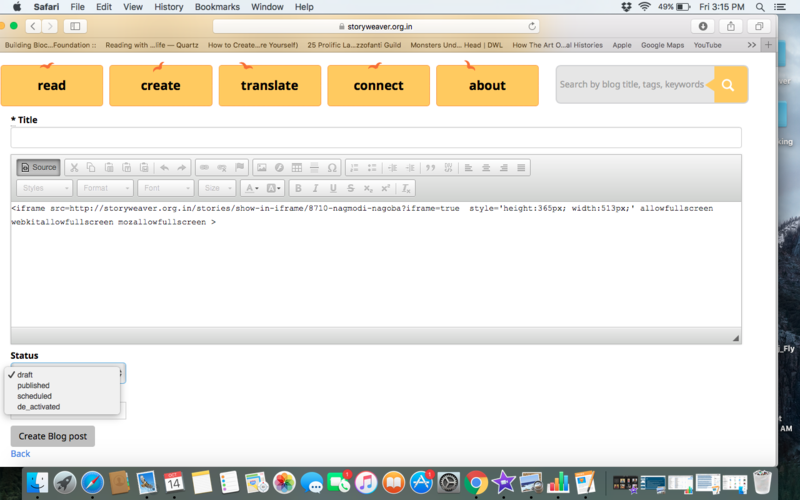
5. Go back to your text editor and finish writing your amazing post.
6. Click on Publish.
7. Voila! Your blog post with an embedded story is now ready to share and dazzle the world with!
Here's how the story will appear on your blog or website once embedded:
Be the first to comment.
Spotting Books That Encourage Children to Sharpen Their Eyes
Posted by Yamini Vijayan on October 28, 2016Spotting books are a great way for children to engage with the book actively and for the reading experience to be an immersive one. It encourages them to explore the illustrations, and also make connections between words and images. We’ve been looking at a range of spotting books and it’s fascinating to see the different ways in which spotting has been made appealing to children. Here are a few books and illustrations that caught our attention!
How many animals and birds can you spot in this illustration by Vinayak Varma from 'Jadav and the Tree-Place'?
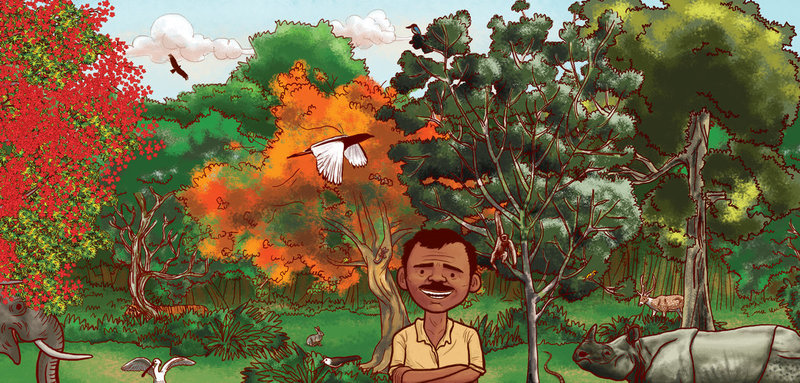
Scholastic has a range of spotting books ('I Spy' series). You can see their entire collection here.
Usborne has a collection of really amazing spotting books too: from bugs and butterflies, to adventures under the sea and in the night sky. In these, there are MANY things to spot. Here is an example.
Then there are the really clever ones, like Delphine Chedru’s ‘Spot It!: Find the Hidden Creatures’ and ‘The Odd One Out’ by Britta Teckentrup. In these, there are fewer things to spot but what makes it compelling is the imaginative manner in which the objects or creatures are hidden. It even works as pattern recognition.
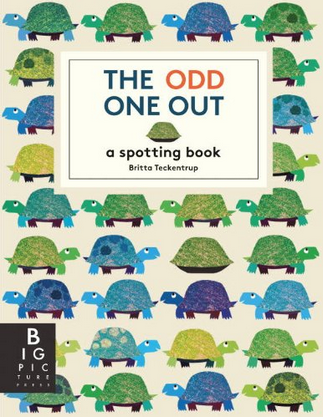
Closer home, there are wonderful books by renowned author-illustrator Manjula Padmanabhan which have been published by Tulika. Take a peek at ‘I Am Different!’ and ‘We Are Different!’. Manjula Padmanabhan has also created wordless books for National Book Trust, which are bursting with interesting details because of which they also work as fantastic spotting books. Here's 'A Visit to the City Market' which was published by NBT in 1986.
One of our absolute favourite illustrations from Pratham Books titles' ('City of Stories') is this incredible illustration by the late Bindia Thapar. So much scope for spotting in this, right?

Hope this has inspired you and given you more amazing ideas for Spotathon! For more Spotathon details related to image size, how to submit your entries and the children we work with, click here.
Be the first to comment.Edu-Cater: Helping children discover a Treasure Trove of stories
Posted by Remya Padmadas on October 28, 2016Edu-Cater, is a group of educators who are striving to create 'healthy learning environments'. They design interventions for facilitators who implement them in their respective learning environments. Each module/intervention typically spans 1-2 weeks. While their work encompasses many spaces, The Edu-Cater team strongly believes in the power of books and reading, which prompted them to start a project called Treasure Trove.
Treasure Trove sets up mini-libraries in schools or settings that have limited or no access to books. So far the team has helped set up 3 mini-libraries across Chennai, Tamil Nadu. Of the three, the team engages closely in one of those settings as the other two spaces had all the resources except access to books, which Treasure Trove helped them acquire.
“We work in a school called Sathya Sai school which is in semi-urban environment in North Chennai. Our target group is Class 5 children. Though this school does not have a proper library, there is tremendous support from their end to inculcate the habit of reading.” shared Sriram Sampath, one of the founding members of Edu-Cater.
Siram outlined what the team does via this intervention:
“In the first year of intervention (when kids are in class 5), we empower them with certain skills we deem to be most important like the ability to create, think and collaborate. In the second year of intervention (when kids move to class 6), we want them to feel confident enough to pick up books and read them.”
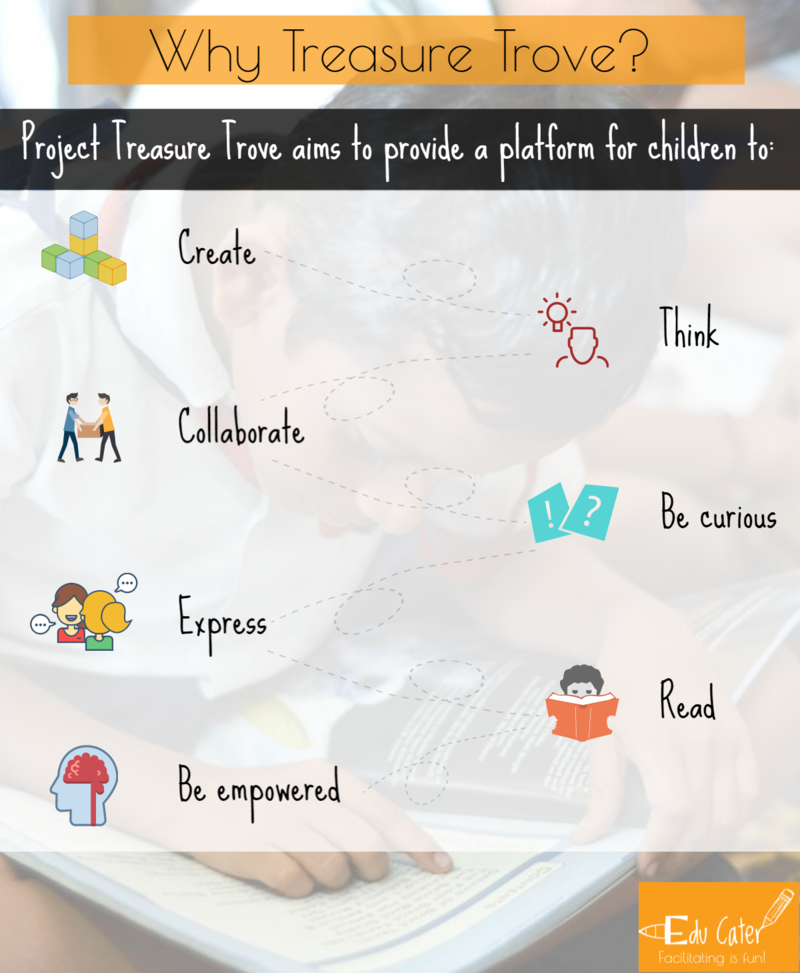
For both these interventions, Team Edu-Cater is using Pratham Books and StoryWeaver.
Introducing new words and books Treasure Trove shared the story 'The day the vegetables came to school' with children and using the story to introduce them to the words 'Author', 'Illustrator' and 'Translator'.
“We gave all the children a small spiral notepad and encouraged them to maintain their own dictionary in it.” recounts Sriram. “The students carried it with them everywhere to record new words that they come across and their meaning. During the course of sharing this story, students noted down many words that were new to them and asked us for the meanings.”
The team noted how children were excited to note down new words and curious about their meanings. “One of the boys had noted down a few words in his dictionary and had managed to locate the meanings of all the words except one during the course of the week.” remembers Sriram “The moment we entered the class at the next session, he headed straight to us and asked us for the meaning of the word!”
Children found many ways to use the notebook, with one doubling it up as a reference book. “He had drawn the parts of the brain in it. When we asked him why he did this, he told us that he wanted to use the book as a quick reference for tough content!”
Create your own story “We divided the children into teams and showed them the wordless version of 'The Birthday Party'. We then asked each team to come up with their own stories based on the original. It was delightful to see them express their ideas, which was the primary objective of the exercise. But what moved us was when they referred to their dictionary and introduced the new words they had learnt in the stories they weaved. It was amazing!” recounts Sriram “One group of girls was determined to use the new words that they had learnt the previous week. They created their story and were identifying spots where they could insert these new words. This sort of student ownership and little moments are what we call impact.”
When Edu-Cater asked one representative from each team to come forward and share their team’s story, more than one person came forward from each group to read out their stories.
“Many teams had more than one member reading out the stories as a result, and they took turns to do this. It really is a sign of their enthusiasm and confidence, to read!” feels Sriram.
The Treasure Trove project caters to around 85 children currently and there are plans to re-engage with last year's batch, making the total number of children impacted 170.
You can see more images from Edu-Cater sessions here: https://www.facebook.com/facilitatingisfun/photos/?tab=album&album_id=1489288461383170
The team’s future plans for class 6 include the purchase of a Library In A Classroom. “With this in the repository, we are confident that we can get the class 6 kids to pick up books of their choice and start reading!”
Good Luck to Sriram and his team! We look forward to reading more about them and their work!
Be the first to comment.